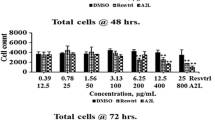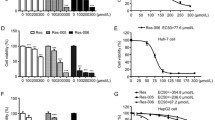Abstract
Resveratrol, present in grapes and other plants, is a polyphenolic compound with strong antioxidative activity. In our previous studies, we found that reactive oxygen species (ROS) accelerated the invasive capacity of a rat ascites hepatoma cell line of AH109A in culture and that resveratrol and resveratrol-loaded rat sera suppressed the ROS-potentiated invasion of the hepatoma cells. To study mechanisms by which resveratrol and itsin vivo metabolite(s) suppress the invasion, we estimated intracellular peroxide level and expression of hepatocyte growth factor (HGF), a known cell motility factor, in AH109A cells. Exogenously added ROS promoted the intracellular peroxide level and the expression of HGF. Resveratrol and resveratrol-loaded rat sera canceled the rise in the peroxide level and HGF expression in ROS-stimulated tumor cells. These results suggest an involvement of the antioxidative property of resveratrol and sera from rats orally given resveratrol in their suppressive effects on ROS-potentiated invasion of AH109A cells.
Similar content being viewed by others
Abbreviations
- AH109A:
-
a rat ascites hepatoma cell line of AH109A
- CMC:
-
carboxymethyl cellulose sodium salt
- CS:
-
calf serum
- DCFH-DA:
-
2’,7’-dichlorofluorescin diacetate
- DMSO:
-
dimethyl sulfoxide
- ELISA:
-
enzyme-linked immunosorbent assay
- HGF:
-
hepatocyte growth factor
- HX:
-
hypoxanthine
- IC50 :
-
50% inhibitory concentration
- M-cells:
-
rat mesentery-derived mesothelial cells
- MEM:
-
Eagle’s minimum essential medium
- PBS:
-
phosphate buffered saline
- ROS:
-
reactive oxygen species
- RS:
-
rat serum
- XO:
-
xanthine oxidase
References
LA Liotta U Wewer NC Rao et al. (1998) ArticleTitleBiochemical mechanism of tumor invasion and metastasis. Clinical & Experimental Metastasis 256 3–16
TP Szatrowski CF Nathan (1991) ArticleTitleProduction of large amount of hydrogen peroxide by human tumor cells. Clinical & Experimental Metastasis 51 794–798
Y Kozuki Y Miura K Yagasaki (2000) ArticleTitleInhibitory effects of carotenoids on the invasion of rat ascites hepatoma cells in culture. Clinical & Experimental Metastasis 151 111–115
Y Kozuki Y Miura K Yagasaki (2001) ArticleTitleInhibitory effect of curcumin on the invasion of rat ascites hepatoma cells in vitro and ex␣vivo. Clinical & Experimental Metastasis 35 57–63
G Zhang Y Miura K Yagasaki (2001) ArticleTitleInhibition of hepatoma cell invasion beneath mesothelial-cell monolayer by sera from tea- and related component-treated rats and their modes of action. Clinical & Experimental Metastasis 36 187–193
M Jang L Cai GO Udeani et al. (1997) ArticleTitleCancer chemopreventive activity of resveratrol, a natural product derived from grapes. Clinical & Experimental Metastasis 275 218–220
B Fauconneau P Waffo-Teguo F Huguet et al. (1997) ArticleTitleComparative study of radical scavenger and antioxidant properties of phenolic compounds from Vitis vinifera cell cultures using in vitro tests. Clinical & Experimental Metastasis 61 2103–2110
Y Kozuki Y Miura K Yagasaki (2001) ArticleTitleResveratrol suppresses hepatoma cell invasion independently of its anti-proliferative action. Clinical & Experimental Metastasis 167 151–156
C Parr WG Jiang (2001) ArticleTitleExpression of hepatocyte growth factor/scatter factor, its activator, inhibitors and the c-Met receptor in human cancer cells. Clinical & Experimental Metastasis 19 857–863
Y Miura Y Kozuki K Yagasaki (2003) ArticleTitlePotentiation of invasive activity of hepatoma cells by reactive oxygen species is mediated by autocrine loop of hepatocyte growth factor. Clinical & Experimental Metastasis 305 160–165
H Akedo K Shinkai M Mukai et al. (1986) ArticleTitleInteraction of rat ascites hepatoma cells with cultured mesothelial cell layers: a model for tumor invasion. Clinical & Experimental Metastasis 46 2416–2422
Y Miura H Shiomi F Saka et al. (1997) ArticleTitleAssay systems for screening food components that have anti-proliferative and anti-invasive activity to rat ascites hepatoma cells: in vitro and ex vivo effects of green tea extract. Clinical & Experimental Metastasis 23 127–132
DA Bass JW Parce LR Dechatelet et al. (1983) ArticleTitleFlow cytometric studies of oxidative product formation by neutrophils: A guarded response to membrane stimulation. Clinical & Experimental Metastasis 130 1910–1917
V Neaud S Faouzl J Guirouilh et al. (1997) ArticleTitleHuman hepatic myofibroblasts increase invasiveness of hepatocellular carcinoma cells: evidence for a role of hepatocyte growth factor. Clinical & Experimental Metastasis 26 1458–1466
P Chomczynski N Sacchi (1987) ArticleTitleSingle-step method of RNA isolation by acid guanidium thiocyanate-phenol-chloroform extraction. Clinical & Experimental Metastasis 162 156–159
C Thomas GF Vile CC Winterbourn (1993) ArticleTitleThe hydrolysis product of ICRF-187 promotes iron-catalysed hydroxyl radical production via the Fenton reaction. Clinical & Experimental Metastasis 45 1967–1972
CX Zhou LD Kong WC Ye et al. (2001) ArticleTitleInhibition of xanthine, monoamine oxidases by stilbenoids from Veratrum taliense. Clinical & Experimental Metastasis 67 158–161
D Miura Y Miura K Yagasaki (2003) ArticleTitleHypolipidemic action of dietary resveratrol, a phytoalexin in grapes and red wine, in hepatoma-bearing rats. Clinical & Experimental Metastasis 73 1393–1400
Author information
Authors and Affiliations
Corresponding author
Rights and permissions
About this article
Cite this article
Miura, D., Miura, Y. & Yagasaki, K. Resveratrol inhibits hepatoma cell invasion by suppressing gene expression of hepatocyte growth factor via its reactive oxygen species-scavenging property. Clin Exp Metastasis 21, 445–451 (2004). https://doi.org/10.1007/s10585-004-2698-1
Received:
Accepted:
Issue Date:
DOI: https://doi.org/10.1007/s10585-004-2698-1




